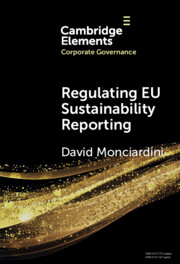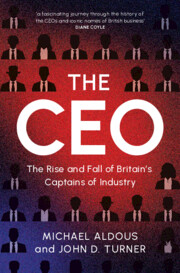Refine search
Actions for selected content:
336 results
4 - The Square Peg
-
-
- Book:
- The Ethics of ESG
- Published online:
- 27 December 2025
- Print publication:
- 22 January 2026, pp 111-134
-
- Chapter
- Export citation
1 - ESG as Dead and Alive
-
-
- Book:
- The Ethics of ESG
- Published online:
- 27 December 2025
- Print publication:
- 22 January 2026, pp 21-50
-
- Chapter
- Export citation
7 - Improving Corporate Governance
- from Part III - Legal Frameworks
-
- Book:
- The Principles of Family Business Law
- Published online:
- 12 December 2025
- Print publication:
- 08 January 2026, pp 119-149
-
- Chapter
- Export citation
3 - Integrating Family and Business Values
- from Part I - Theory
-
- Book:
- The Principles of Family Business Law
- Published online:
- 12 December 2025
- Print publication:
- 08 January 2026, pp 43-60
-
- Chapter
- Export citation
2 - Distinctive Features of Family Businesses
- from Part I - Theory
-
- Book:
- The Principles of Family Business Law
- Published online:
- 12 December 2025
- Print publication:
- 08 January 2026, pp 24-42
-
- Chapter
- Export citation
9 - Stewardship
- from Part IV - Societal Impact
-
- Book:
- The Principles of Family Business Law
- Published online:
- 12 December 2025
- Print publication:
- 08 January 2026, pp 175-204
-
- Chapter
- Export citation
The Dawn of Shareholder Value: The Normalization of the Hostile Takeover in the UK 1952–1954
-
- Journal:
- Enterprise & Society , First View
- Published online by Cambridge University Press:
- 18 November 2025, pp. 1-30
-
- Article
-
- You have access
- Open access
- HTML
- Export citation
Government intervention, political connections, and stock performance: an event study from Argentina
-
- Journal:
- Business and Politics , First View
- Published online by Cambridge University Press:
- 21 October 2025, pp. 1-23
-
- Article
-
- You have access
- Open access
- HTML
- Export citation

Regulating EU Sustainability Reporting
- Learning from Failure and Success
-
- Published online:
- 11 October 2025
- Print publication:
- 13 November 2025
-
- Element
- Export citation
Chapter 10 - An overview of directors’ duties
-
- Book:
- Contemporary Australian Corporate Law
- Published online:
- 11 September 2025
- Print publication:
- 25 September 2025, pp 307-346
-
- Chapter
- Export citation
Heightened Human-Rights Due Diligence as Risk Governance: Food-Retail Supply Chains in Wartime Ukraine
-
- Journal:
- European Journal of Risk Regulation , First View
- Published online by Cambridge University Press:
- 23 September 2025, pp. 1-17
-
- Article
-
- You have access
- Open access
- HTML
- Export citation

Contemporary Australian Corporate Law
-
- Published online:
- 11 September 2025
- Print publication:
- 25 September 2025
-
- Textbook
- Export citation
12 - Clinical governance
- from Part 3 - Engages Others
-
-
- Book:
- Leading and Managing Health Services
- Published online:
- 15 August 2025
- Print publication:
- 28 August 2025, pp 131-141
-
- Chapter
- Export citation
6 - Liability Management and the Transformation of Deutsche Bank
-
- Book:
- Extroverted Financialisation
- Published online:
- 07 August 2025
- Print publication:
- 21 August 2025, pp 105-126
-
- Chapter
- Export citation
21 - Generative AI Systems and Corporate Governance, Compliance and Liability
- from Part III - Generative AI
-
-
- Book:
- The Cambridge Handbook of Generative AI and the Law
- Published online:
- 08 August 2025
- Print publication:
- 07 August 2025, pp 367-391
-
- Chapter
- Export citation
Chapter 6 - The Election of a Rector
-
- Book:
- The Power of Dissent
- Published online:
- 07 August 2025
- Print publication:
- 07 August 2025, pp 181-198
-
- Chapter
- Export citation
Together we win: The impact of board internationalization and board size on strategic change
-
- Journal:
- Journal of Management & Organization , First View
- Published online by Cambridge University Press:
- 21 July 2025, pp. 1-23
-
- Article
-
- You have access
- Open access
- HTML
- Export citation

The CEO
- The Rise and Fall of Britain's Captains of Industry
-
- Published online:
- 19 June 2025
- Print publication:
- 19 June 2025
7 - Captains of Industry
-
- Book:
- The CEO
- Published online:
- 19 June 2025
- Print publication:
- 19 June 2025, pp 216-238
-
- Chapter
- Export citation
6 - Fat Cats
-
- Book:
- The CEO
- Published online:
- 19 June 2025
- Print publication:
- 19 June 2025, pp 170-215
-
- Chapter
- Export citation
